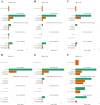Cardiac disease in patients with vasculitis
- PMID: 40853447
- PMCID: PMC12408678
- DOI: 10.1007/s00392-025-02728-y
Cardiac disease in patients with vasculitis
Abstract
Background: Cardiac involvement has been described in many forms of vasculitides and is associated with worse outcomes. However, data on the incidence of structural and arrhythmic heart disease is limited.
Methods: For this single-center study, we recruited 191 patients with giant-cell arteritis (GCA, n = 109), Takayasu arteritis (TAK, n = 26), polyarteritis nodosa (PAN, n = 3), granulomatosis with polyangiitis (GPA, n = 38), or eosinophilic granulomatosis with polyangiitis (EGPA, n = 15) between August 2023 and January 2025. The primary study endpoint was the incidence of structural or arrhythmic heart disease after the diagnosis of vasculitis.
Results: The demographic characteristics of patients diagnosed with vasculitis differed significantly between those with GCA, TAK, PAN, GPA, and EGPA. Arterial hypertension and dyslipidemia at baseline were more prevalent among patients with GCA, while chest pain and signs of congestion were more frequently reported by patients with EGPA. No significant difference between the five main subgroups were found regarding the incidence of documented arrhythmic diseases. Cardiac imaging was performed using echocardiography in 70% of the overall cohort and cardiac magnetic resonance (CMR) in 11%. CMR detected left ventricular systolic dysfunction and myocardial fibrosis in 33% and 40% of EGPA patients, respectively. All four cases of acute myocardial infarction occurred in patients with GCA. Among 19 GCA patients who underwent coronary angiography, 21.1% underwent percutaneous coronary intervention. In the EGPA group, coronary angiography was performed in 46.7% of patients, but none required percutaneous intervention. A substantial proportion of patients was treated with acetylsalicylic acid (50.3%), beta-blockers (41.9%), or ACE-inhibitors/AT1-receptor antagonists (60.2%).
Conclusion: Severe cardiac complications occurred rarely, although cardiovascular risk factors, structural abnormalities, and arrhythmias affected a substantial proportion of patients with vasculitis, highlighting the potential benefit of systematic screening and multidisciplinary management.
Keywords: Cardiac arrhythmia; Structural heart disease; Vasculitis.
© 2025. The Author(s).
Conflict of interest statement
Declarations. Ethical standards: All ethical standards were met in writing and submitting this correspondence. Conflicts of interest: None. Data sharing agreement: The data are not publicly available due to ethical restrictions and legal constraints. Readers may contact the corresponding authors for reasonable requests for the data. De-identified data may be provided after approval from the ethical review board.
Figures



References
-
- Jennette JC, Falk RJ, Bacon PA et al (2013) 2012 revised international chapel hill consensus conference nomenclature of vasculitides. Arthritis Rheum 65(1):1–11 - PubMed
-
- Silveira LH (2020) Cardiovascular manifestations of systemic vasculitides. Curr Rheumatol Rep 22:72 - PubMed
-
- Pazzola G, Pipitone N, Salvarani C (2020) Cardiac involvement in the adult primary vasculitides. Expert Rev Clin Immunol 16:985–991 - PubMed
-
- Misra DP, Shenoy SN (2017) Cardiac involvement in primary systemic vasculitis and potential drug therapies to reduce cardiovascular risk. Rheumatol Int 37:151–167 - PubMed
MeSH terms
LinkOut - more resources
Full Text Sources
Medical
Research Materials
Miscellaneous

